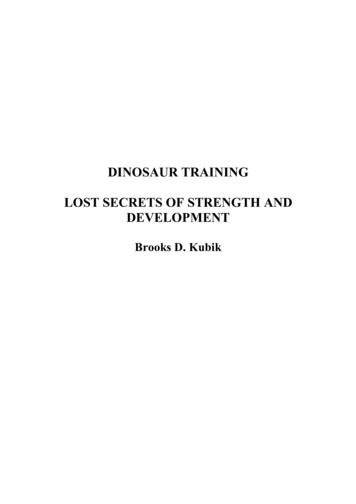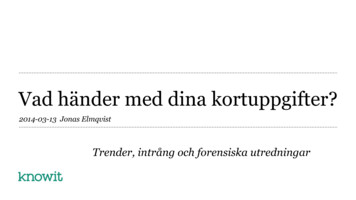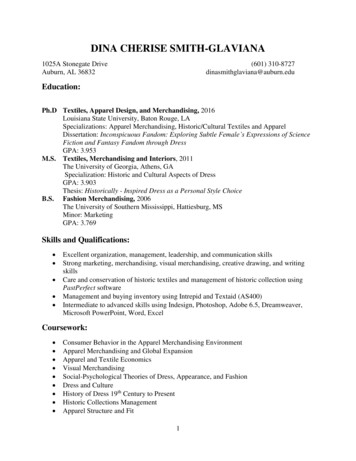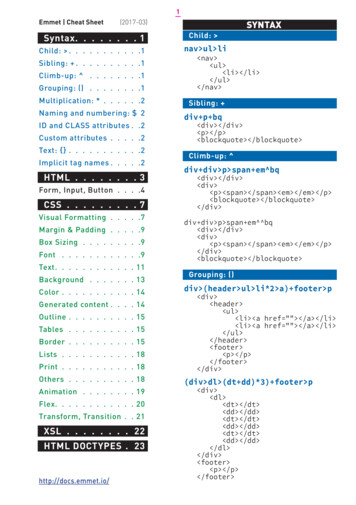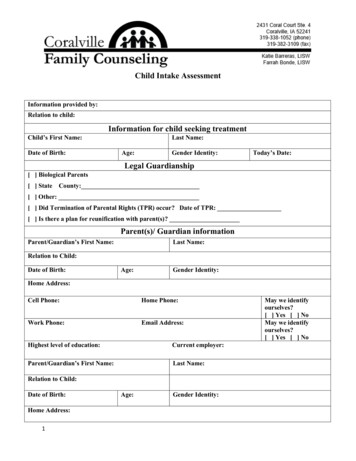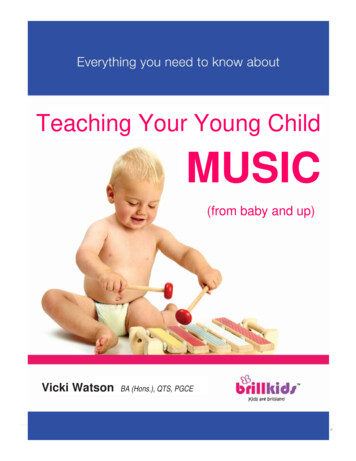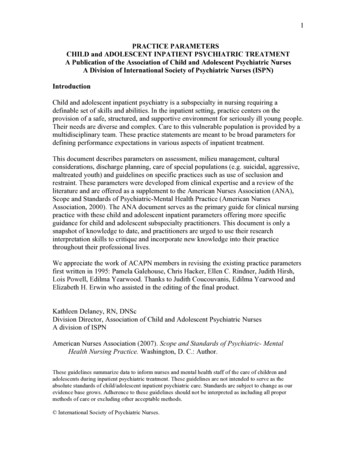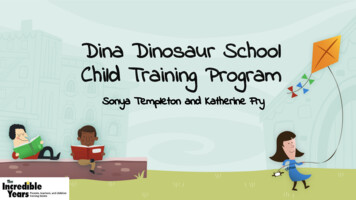
Transcription
Dina Dinosaur SchoolChild Training ProgramSonya Templeton and Katherine Fry
Ice BreakerShake hands with a friend andsay hello x3It’s dinosaur school today, youknow!
Dina’s School Rules:1.2.3.4.5.Eyes on the teacherQuiet, hands upListening earsInside voicesWorking hard
The Five W’s1) Who? Children aged 3-8 with social, emotional orbehavioural concerns or diagnoses such as: Oppositional Defiant DisorderAttention Deficit Hyperactivity DisorderConduct Disorder Parents are involved in the at-home portion of theintervention Can be implemented by counsellors,therapists, SERTS, or other trainedprofessionals
2) What? A curriculum of five units delivered in a classroomformat How to Do Your Best in School Understanding and Detecting Feelings Detective Wally Teaches Problem-Solving Steps(Restraining impulsivity and thinking about consequences) Detective Wally Teaches Problem-Solving Steps(Recognizing and managing anger) Molly Manners Teaches How to Be Friendly
2) What? *Cont’d Children engage in role playing with puppets,watching video vignettes, and table activities
3) Where? It can be implemented through small treatment groupsoffered by mental health agencies, such as Adventure Placeand CAMH The curriculum can also be offered within a schoolclassroom setting for all children, with a focus onprevention of maladaptive behaviour
4) When? The small group intervention takes place in 2-hoursessions each week for 18 to 22 weeks The school classroom curriculum takes place throughoutthe entire school year in two 1-hour sessions each week
5) Why? It’s Evidence-Based! Found to lead to significant decreases in conduct problems ina pre- and post-intervention comparison, whereas the controlgroup showed increases in behavioural issues (WebsterStratton, Reid, & Hammond, 2001) Children were able to provide a greater number and varietyof prosocial solutions to hypothetical conflict situations(Webster-Stratton et al., 2001)
5) Why? It’s Evidence-Based! *Cont’d Helps children build the skills of making friends, conflictresolution and social problem-solving skills, and peergroup-entry skills (Best Start Expert Panel on EarlyLearning, 2007) Benefits have been shown to be maintained over timeand generalized across environments (WebsterStratton et al., 2001; Webster-Stratton & Reid, 2003) Note: Carolyn Webster-Stratton is the creator of theprogram
How is the Dinosaur CurriculumImplemented? (The Incredible Years, 2013) 3 DVD Set (4 hours)Comprehensive Therapist ManualDinosaur Home Activities ManualWally’s Detective Books for SolvingProblems (set of 4)Wally’s Feeling Wheel Posters (2 types)Calm Down Thermometer PosterWally’s Detective Kit Box (47 laminated andcolored cue cards for teaching social skills,anger management and problem solvingconcepts)StickersDina MagnetIncredible Teachers Book(The Incredible Years, 2013)
Pop Quiz!What are some generalstrategies you might use toshape or change negativebehaviours?
Strategies for BehaviourGeneral StrategiesPositive reinforcementNatural consequencesToken economyExtinction/IgnoringRedirectionDinosaur School StrategiesPositive reinforcementTime outDinosaur TokensChildren called on only whendisplaying appropriate behaviourChildren have opportunities tobe a leader
Calm Down ThermometerIf you are feeling frustrated,your body will look like this:If you are feeling happy andcalm, your body will look like this:
Calm Down Thermometer1.2.3.When you feel upset, find the designated ‘Calm Down’area and sit down.Stop and think! Take THREE deep breaths. Ask yourself ifyou feel better or if you need to take more deep breaths.If you have calmed down into the green zone, your bodyis relaxed and you can go go back to the group?
Implementation InvestigationProfessionals have stated that the intervention itself hasbeen very successful The children are developing positive behaviours The children have been really engaged within therole play and activities The puppets have “come alive” and the childrenlove them!However, some aspects of the implementation have been astruggle for the professionals in regards to: Limited time frame to practice and implement theprogram Program delivery
Strengths Intervention within an intervention Materials Cool down thermometer, puppets, fidelity checklistsVideo vignettes show real-life situations Implementer training is extensive Intervention can be tailored to children’s needs Uses a collaborative approach (Webster-Stratton, 2004)
Strengths Variety of puppets representing the ethnicity andgender of the children in the group are used(Webster-Stratton & Reid, 2003) Aspects of the program can be implemented inmultiple settings Includes parents through at-home portion “Side effects” Communication, language, writing
Weaknesses Consideration of developmental levels (Webster-Stratton& Reid, 2003) Potential for children to reinforce each other’s negativebehaviours (Webster-Stratton & Reid, 2003) Accreditation is not necessary for trainers to implementthe program Rigidity Implementers must play the same puppet character every time Fidelity checklists are very specific
Role of the Consultant Possible to become trained in order to offer theintervention within your agency Educate families about the program and making referrals Assist the parents, child care staff, or school teachers inusing strategies/vocabulary from the program acrosssettings Support parents in the at-home portion of the program
Recommendations and Considerations This intervention appears to be appropriate for the intendedaudience, however age 3 may be too young for children tounderstand all the content Could potentially be beneficial to include typically developingchildren to reduce reinforcement of negative behaviours Implementers should consider time commitment, due torigidity of the program Parents should consider the amount of their involvementrequired, to be sure they can commit to helping childwith at-home activities
Thank you!Any questions or thoughts?
ReferencesBest Start Expert Panel on Early Learning. (2007). Early Learning for Every Child Today: A frame work for Ontario earlychildhood setting. Retrieved from 010/10/ELECT.pdfThe Incredible Years (2013). Small group dinosaur curriculum. Retrieved from -curriculum/The Incredible Years. (2014, February 13). Child Program Overview (Brief) [Video File]. Retrieved from https://www.youtube.com/watch?v 7ncHOZv2EJgWebster-Stratton, C., Reid, J., & Hammond, M. (2001). Social skills and problem-solving training for children with earlyonset conduct problems: Who benefits? Journal of Child Psychology and Psychiatry, 42(7), 943-952.Webster-Stratton, C., & Reid, M. J. (2003). Treating conduct programs and strengthening social and emotionalcompetence in young children: The dina dinosaur treatment program. Journal of Emotional and BehaviouralDisorders, 11(3), 130-143.
Dina Dinosaur School Child Training Program Sonya Templeton and Katherine Fry. Ice Breaker Shake hands with a friend and say hello x3 It’s dinosaur school today, you know! Dina’s School Rules: 1. Eyes on the teacher 2. Quiet, hands up 3. Listening ears 4. Inside voices 5. Working hard. The Five W’s Children aged 3-8 with social, emotional or behavioural concerns or diagnoses such as .

